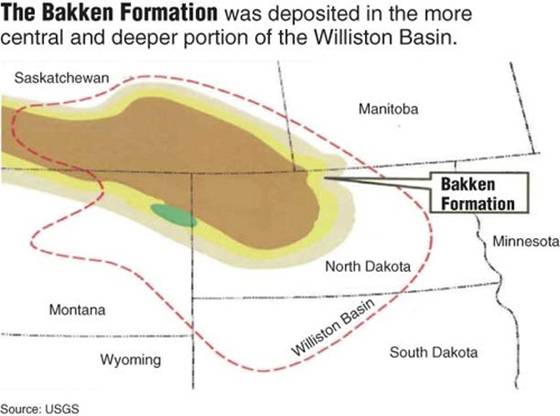This'll blow your socks off.
OIL - you better sit down.
Here's
an interesting read, important and verifiable information :
About 6 months ago, the writer was watching a news program on oil and
one of the Forbes Bros. was the guest. The host said to Forbes,
"I am going to ask you a direct question and I would like a
direct answer; how much oil does the U.S. have in the
ground?" Forbes did not miss a beat, he said, "more
than all the Middle East put together."
Please read below.
The U. S. Geological Service issued a report in April 2008
that only
scientists and oil men knew was coming, but man was it big. It was a
revised report (hadn't been updated since 1995) on how much oil was in
this area of the western 2/3 of North Dakota , western
South Dakota , and extreme
eastern Montana ...... check THIS out:

http://bakkenshale.net/bakkenshalemap.html
The
Bakken is the largest domestic oil discovery since Alaska 's
Prudhoe Bay, and has the potential to eliminate all American dependence
on foreign oil. The Energy Information Administration (EIA)
estimates it at 503 billion barrels. Even if just 10% of the oil is
recoverable... at $107 a barrel, we're looking at a resource base worth
more than $5.3 trillion.
"When I first briefed legislators on this, you could practically
see their jaws hit the floor. They had no idea.." says Terry
Johnson, the Montana Legislature's financial analyst.
"This sizable find is now the highest-producing onshore oil field
found in the past 56 years," reports The Pittsburgh Post
Gazette. It's a formation known as the Williston Basin , but
is more commonly referred to as the 'Bakken.' It stretches from Northern
Montana, through North Dakota and into Canada .. For
years, U. S. oil exploration has been considered a dead end.
Even the 'Big Oil' companies gave up searching for major oil wells
decades ago. However, a recent technological breakthrough has opened up
the Bakken's massive reserves.... and we now have access of up to 500
billion barrels. And because this is light, sweet oil, those billions of
barrels will cost Americans just $16 PER BARREL!
That's enough crude to fully fuel the American economy for 2041
years straight. And if THAT didn't throw you on the floor, then
this next one should - because it's from 2006!
U. S. Oil Discovery- Largest Reserve in the World
Stansberry Report Online - 4/20/2006
Hidden 1,000 feet beneath the surface of the Rocky Mountains
lies the largest untapped oil reserve in the world. It
is more than 2 TRILLION barrels. On August 8, 2005 President Bush
mandated its extraction. In three and a half years of high oil
prices none has been extracted. With this motherload of oil why are
we still fighting over off-shore drilling?
They reported this stunning news: We have more oil inside our borders,
than all the other proven reserves on earth. Here are the official
estimates:
- 8-times as much oil as Saudi Arabia
- 18-times as much oil as Iraq
- 21-times as much oil as Kuwait
- 22-times as much oil as Iran
- 500-times as much oil as Yemen
- and it's all right here in the Western United States .
HOW can this BE? HOW can we NOT BE extracting this? Because the
environmentalists and others have blocked all efforts to help
America become independent of foreign oil! Again, we are letting a
small group of people dictate our lives and our economy.....WHY?
James Bartis, lead researcher with the study says we've got more oil in
this very compact area than the entire Middle East -more
than 2 TRILLION barrels untapped. That's more than all the proven
oil reserves of crude oil in the world today, reports The
Denver Post.
Don't think 'OPEC' will drop its price - even with this find? Think
again! It's all about the competitive marketplace, - it has to.
Think OPEC just might be funding the environmentalists?
Got your attention yet?
By the way...this is all true. Check it out at the link below!!!
GOOGLE it, or follow this link. It will blow your mind.
http://www.usgs.gov/newsroom/article.asp?ID=1911 <http://www.usgs.gov/newsroom/article.asp?ID=1911>
<http://www.usgs.gov/newsroom/article.asp?ID=1911 <http://www.usgs.gov/newsroom/article.asp?ID=1911
|



![]() We have never been "dependant" on the Muslim oil, and never would
be. So, the question must be asked, "Why then are we sending BILLIONS
to the Muslim nations through the purchase of their oil?" There are
probably several different reasons, but the main point here is, WE ARE BEING
LIED TO!!!
We have never been "dependant" on the Muslim oil, and never would
be. So, the question must be asked, "Why then are we sending BILLIONS
to the Muslim nations through the purchase of their oil?" There are
probably several different reasons, but the main point here is, WE ARE BEING
LIED TO!!!